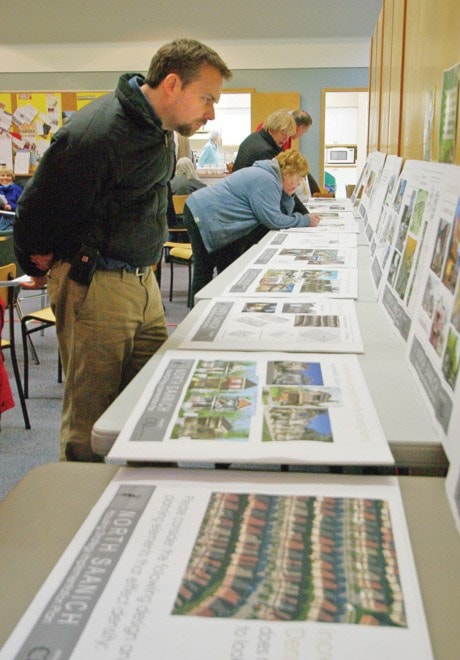A consultant wants to help North Saanich resolve outstanding housing density issues and is leading a community consultation process which had its first public open house Tuesday.
A small group of concerned citizens, however, feels the process goes too far and assumes most people in the district want higher density housing — a question they think needs to be answered first.
At the Saanich Peninsula Presbyterian Church on Jan. 29, a full house was on hand to hear Ed Grafone of CTQ Consultants Ltd. of Kelowna outline the process of gathering opinions and information to meet the terms established by the District of North Saanich.
“This is an important issue in North Saanich,” he said. “It’s sensitive, as it could set the stage to change the character of the community. Real discussion is needed on how other forms of housing and how it can be made to fit in.”
The goal of the process, added the district’s director of planning Mark Brodrick, is to look into how to implement three housing strategy recommendations, left out of the 2008 housing strategy. Those — known as recommendations 5, 6 and 7 — call for allowing smaller lot residential development, multi-unit low density (15 units per acre) and multi-unit medium density (25 units per acre). The district’s current residential, single family home, zoning (R1) allows for only 2.5 units per acre.
By way of comparison, the proposed housing development at 9395 East Saanich Road is 39 or 40 units over 4.3 acres — which is approximately nine units per acre.
“This consultation is to consider increased densities in terms of workforce housing,” Brodrick said. “It could have long-term implications for the district’s OCP (official community pan) and housing policies.”
Grafone said his part of the process is to gather public opinion and ideas on how much of that might look.
“We are looking to confirm public values and perspectives on housing,” he said, adding the community will address issues of affordable housing, types of construction, housing needs and concerns.
Springfield Harrison is concerned the right question isn’t being asked.
A member of a small group of concerned citizens leading the opposition to this process, Harrison said it bypasses the issue of whether people want higher densities in the first place.
“The implication here is that higher densities are pre-supposed,” he said, adding he believes most people don’t want it at all and want the community to stay the same.
He added he doesn’t think there’s as great a workforce housing demand as being touted by local industry and a majority of district politicians. Harrison said in the scope of the overall Capital Regional District, largely rural North Saanich has its agricultural role, while other communities — like Sidney or Langford — provide most of the housing.
Harrison said a survey being distributed by the consultant does offer space for people to let their opinions be known on the matter, but he added he believes some of the information in the survey is incorrect. Either way, he hopes people become as informed as possible when formulating their opinions on the issue.
The term density, Grafone said, can frighten people.
‘It means change, but it represents the way that people are living now — increased density on similar land sizes.”
Grafone added that over the last five to 10 years, most municipalities in B.C. are following a trend towards more small-lot single family homes. It means more efficient use of land and lower prices for the subsequently smaller homes.
“Not that this is what has to occur here,” he added, noting that public opinion might tell them something completely different.
“If there’s an interest to accommodate higher density, there are ways to achieve this,” Grafone continued, adding those include ways to hold developers and politicians to account for form and character and overall housing policies.
Tuesday night’s open house was the first of two. A second is planned for later this month, but a date has not yet been set.
CTQ will be interviewing stakeholders on both sides of the housing issue as they gather information for their final report to council, expected some time in March.
